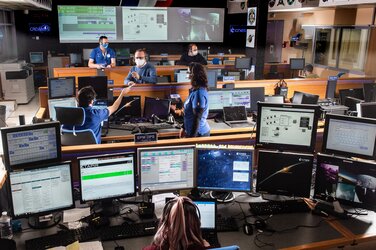Accept all cookies Accept only essential cookies See our Cookie Notice

About ESA
The European Space Agency (ESA) is Europe’s gateway to space. Its mission is to shape the development of Europe’s space capability and ensure that investment in space continues to deliver benefits to the citizens of Europe and the world.
Highlights
ESA - United space in Europe
This is ESA ESA facts Member States & Cooperating States Funding Director General Top management For Member State Delegations European vision European Space Policy ESA & EU Space Councils Responsibility & Sustainability Annual Report Calendar of meetings Corporate newsEstablishments & sites
ESA Headquarters ESA ESTEC ESA ESOC ESA ESRIN ESA EAC ESA ESAC Europe's Spaceport ESA ESEC ESA ECSAT Brussels Office Washington OfficeWorking with ESA
Business with ESA ESA Commercialisation Gateway Law at ESA Careers Cyber resilience at ESA IT at ESA Newsroom Partnerships Merchandising Licence Education Open Space Innovation Platform Integrity and Reporting Administrative Tribunal Health and SafetyMore about ESA
History ESA Historical Archives Exhibitions Publications Art & Culture ESA Merchandise Kids Diversity ESA Brand Centre ESA ChampionsLatest
Space in Member States
Find out more about space activities in our 23 Member States, and understand how ESA works together with their national agencies, institutions and organisations.
Science & Exploration
Exploring our Solar System and unlocking the secrets of the Universe
Go to topicAstronauts
Missions
Juice Euclid Webb Solar Orbiter BepiColombo Gaia ExoMars Cheops Exoplanet missions More missionsActivities
International Space Station Orion service module Gateway Concordia Caves & Pangaea BenefitsLatest
Space Safety
Protecting life and infrastructure on Earth and in orbit
Go to topicAsteroids
Asteroids and Planetary Defence Asteroid danger explained Flyeye telescope: asteroid detection Hera mission: asteroid deflection Near-Earth Object Coordination CentreSpace junk
About space debris Space debris by the numbers Space Environment Report In space refuelling, refurbishing and removingSafety from space
Clean Space ecodesign Zero Debris Technologies Space for Earth Supporting Sustainable DevelopmentApplications
Using space to benefit citizens and meet future challenges on Earth
Go to topicObserving the Earth
Observing the Earth Future EO Copernicus Meteorology Space for our climate Satellite missionsCommercialisation
ESA Commercialisation Gateway Open Space Innovation Platform Business Incubation ESA Space SolutionsLatest
Enabling & Support
Making space accessible and developing the technologies for the future
Go to topicBuilding missions
Space Engineering and Technology Test centre Laboratories Concurrent Design Facility Preparing for the future Shaping the Future Discovery and Preparation Advanced Concepts TeamSpace transportation
Space Transportation Ariane Vega Space Rider Future space transportation Boost! Europe's Spaceport Launches from Europe's Spaceport from 2012Latest

HTV-9 approaches the International Space Station
Thank you for liking
You have already liked this page, you can only like it once!
The Japanese cargo ferry HTV-9 moments before the Canadarm2 robotic arm (right) captured the spacecraft on 25 May 2020. Expedition 63 Commander and NASA astronaut Chris Cassidy was at the robotics controls ready to command the Canadarm2 to reach out and grapple the HTV-9 that was carrying over four tonnes of food, supplies and experiments to replenish the International Space Station crew.
It carried a fridge-size experiment facility developed by European industry through an ESA contract. The second iteration of the European Drawer Rack (EDR-2) is destined for the European Columbus laboratory and will provide even greater opportunities for science in space.
As the International Space Station enters its 20th year of operations, EDR-2 is part of a comprehensive upgrade of Columbus to offer flexible access to researchers. The rack was developed by an industrial team led by Thales Alenia Space Italy, based in Turin, Italy.
As the name implies, the facility offers room to support and operate experiments by supplying power, data communication, cooling, nitrogen and venting waste gasses.
The standard-sized racks that fit in all Space Station laboratories are the size of large fridges, and the Japanese HTV can bring several racks to the International Space Station. Once on board they become easier to manipulate for the astronauts in weightlessness.
The EDR-2 will not replace the existing European Drawer Rack but run in parallel, increasing the possibilities of research and technology demonstration in space. EDR-2 will benefit from other Columbus upgrades to modernise data management and improve data-rates for scientists operating their experiments from laboratories on Earth.
The EDR-2 and most of its experiments will be operated from CADMOS, the French User Support Operations Centre located in Toulouse, France. A full-scale Engineering Model of EDR-2 is available at CADMOS to test instruments and prepare experiment operations, as well as run control versions of experiments on Earth to compare with results from space.
-
CREDIT
NASA -
LICENCE
ESA Standard Licence

Installing European Drawer Rack-2

New European rack

CADMOS control room

European Drawer Rack-2















 Germany
Germany
 Austria
Austria
 Belgium
Belgium
 Denmark
Denmark
 Spain
Spain
 Estonia
Estonia
 Finland
Finland
 France
France
 Greece
Greece
 Hungary
Hungary
 Ireland
Ireland
 Italy
Italy
 Luxembourg
Luxembourg
 Norway
Norway
 The Netherlands
The Netherlands
 Poland
Poland
 Portugal
Portugal
 Czechia
Czechia
 Romania
Romania
 United Kingdom
United Kingdom
 Slovenia
Slovenia
 Sweden
Sweden
 Switzerland
Switzerland

























